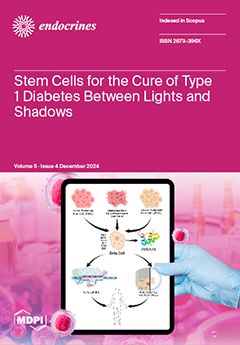Background: Endothelial dysfunction (ED), an early indicator of atherosclerosis, is a well-established predictor of cardiovascular disease. This study investigates ED in children with rare genetic variants linked to obesity and explores the prevalence of these variants in pediatric obesity.
Methods: Under an IRB-approved
[...] Read more.
Background: Endothelial dysfunction (ED), an early indicator of atherosclerosis, is a well-established predictor of cardiovascular disease. This study investigates ED in children with rare genetic variants linked to obesity and explores the prevalence of these variants in pediatric obesity.
Methods: Under an IRB-approved protocol, 54 pediatric patients with severe obesity (BMI ≥ 97%) were screened using the Rhythm
® Genetics Test panel between 2021 and 2024 through the Uncovering Rare Obesity
® program. This clinically approved buccal test targets 79 genes and one chromosomal region. ED was measured using EndoPAT
® (Itamar Medical Ltd by Zoll US based company) in 24 of these patients with related gene variants and compared to controls.
Results: Genetic screening: Among the 54 patients screened, 42 (78%) had positive genetic variants, including 18 males and 24 females. The most common variants were
PCNT (
n = 9),
BBS (
n = 9),
SEMA3 (
n = 8),
ALMS1 (
n = 6),
SDCCAG8 (
n = 5) and
MC4R (
n = 5). Endothelial dysfunction: Included 21 subjects with a mean age of 12 years and a mean BMI of 33.31 kg/m². The mean RHI for patients with the PCNT variant was significantly higher (1.34,
p = 0.02) compared to controls, but no significant differences were observed for other variants, including
BBS,
ALMS1, and
SH2B1.
Conclusions: In this small pilot study, no significant difference in ED was found between children with or without genetic variants, except for
PCNT, which showed a higher RHI. Targeted genetic screening revealed 78% with identified pathogenic variants like
MC4R, which can clinically guide therapy. Further research is needed to investigate ED in children with obesity variants.
Full article




